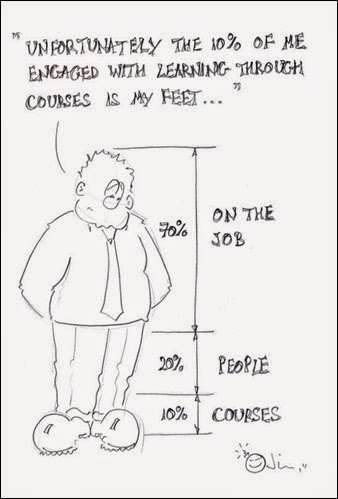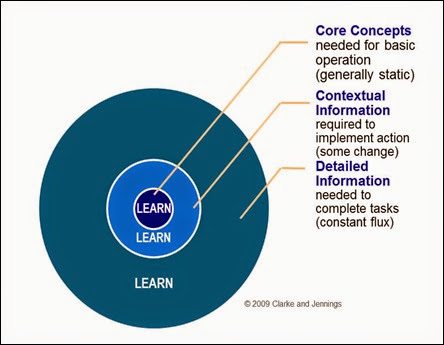 The results of yet another 70:20:10 survey were published recently.
The results of yet another 70:20:10 survey were published recently.
The researchers (possibly on work experience) declared that “50:26:24 is the average learning mix in most companies right now”.
The report of the 50:26:24 survey went on to say:
“It’s widely accepted that the 70:20:10 model is the most effective learning blend for business, but getting to that perfect mix can be a challenge. It’s early days and we’ve got a long way to go, but when we crunched the first numbers on our new study, we could see that the current average mix of training in the L&D industry is actually:
- 50% via ‘on the job learning’
- 26% through ‘informal training’
- 24% from ‘formal training’”
A few things flew off the page from this survey and hit me square in the temple. The comments below are not intended as a blanket criticism of this specific survey, but it did get me thinking about a number of misconceptions of what the 70:20:10 model is really about. It also got me thinking about approaches to organisational learning in general.
Learning ≠ Training
Although the terms convey basic concepts, there seems still to be some confusion between the meaning of the words learning and training. This confusion is not isolated in surveys such as the above. It is a common problem and underlies many of the barriers that organisations encounter as they strive to develop and implement effective learning strategies.
‘Learning’ covers a much wider range of activities than training. Learning is a process not an event. Learning is something we’re doing every day.
Training describes a structured set of events that when designed and assembled carefully can provide an effective way to help people accelerate learning (learning = behaviour change). However the words training and learning are not interchangeable.
This may seem a small point that most of us have ‘got’ and don’t think about, but it’s important. The term ‘informal training’ for example is meaningless. Whereas the term ‘informal learning’ as Jay Cross describes it, is extremely meaningful:
“.. the unofficial, unscheduled, impromptu way most people learn to do their jobs. Informal learning is like riding a bicycle: the rider chooses the destination and the route. The cyclist can take a detour at a moment’s notice to admire the scenery or help a fellow rider."
Jay wrote the seminal book on Informal Learning.
70:20:10 is Not About the Numbers
 The 70:20:10 model is not about percentages or numbers and there is no universal ‘right’ ratio.
The 70:20:10 model is not about percentages or numbers and there is no universal ‘right’ ratio.
70:20:10 is a model that describes the way adults in work generally learn.
So why use the numbers, then?
The numbers are a useful reminder that the majority of learning occurs through experience and practice within the workflow (the ‘70’), through sharing and supporting others, conversations and networks (the ‘20’), and that a smaller amount of overall learning occurs through structured training and development activities (the ‘10’).
70:20:10 is not a recipe to be used slavishly. The numbers are a simple framework to drive change and help people focus beyond structured learning interventions to where most of the learning happens (in the ‘20’ and ‘70’).
I wrote about ‘the numbers’ on this blog back in June 2012. What I said there still holds.
Every organisation that uses the 70:20:10 framework will have individual needs and contexts. The way they support learning and development will be particular to them. If you’re in a high compliance environment it’s likely that your people will be required to spend more time on structured training (whether this has an impact or not is another issue altogether). If you’re working in a highly innovative and creative environment it’s likely your learning and development will be skewed more towards the social and experiential types of development. So the ratios describing how people learn in a large compliance-driven organisation are likely to be different from an agile start-up. How we support learning and building high performance should reflect these differences.
So if you’re supporting effective learning and development in a high compliance context, then you’ll need to be aware that the ‘best’ ratio for your organisation and the individuals will be skewed by regulatory needs. If you’re supporting effective leaning and development in an environment where agility and innovation are at a premium then you’d better be prepared to support higher levels of collaborative and ‘trial-and-error’ learning – in the ‘70’ and ‘20’ zones.
'Training Types’
The 50:26:24 survey categorised three distinct and separate ‘training types’, described in this way:
“Current research suggests that the ideal training mix is 70% On the Job Training, 20% Informal Learning and 10% Formal Learning.”
I found this a strange categorisation.
Now I’m not sure if I’m over-reacting to this approach, or I simply don’t understand it, but ‘on the job training’ suggests structure and intention to me. The ‘training’ word gives that away. But then the input for this survey asks for the ‘current learning mix’ and offers ‘on the job’, ‘informal’ and ‘formal’. On-the-job learning doesn’t have to be structured and intentional. Most isn’t.
I don’t want this post to be a criticism of an individual survey design, but I do think that the designers of data-gathering surveys such as these need to think about the terminology they use carefully. In my mind ‘on-the-job’, ‘informal’ and ‘formal’ are not three mutually exclusive categories.
In real life 'on-the-job' learning can be either informal (i.e. self-directed or non-directed) or formal (i.e. experiential development that is part of a structured course or programme).
‘Formal learning’ suggests learning that is designed and directed by someone other than the learner as part of a curriculum, course, programme, module etc. Formal learning can include on-the-job activities and learning, but not necessarily.
These three types of learning are not dichotomies (if one can have dichotomous trios). The world is not black-and-white.
Without any definitions of these categories (and I couldn't find any in this survey) I fail to see how respondents will provide consistently accurate input. Potentially leading to garbage in, garbage out.
Continuous Learning is the goal of 70:20:10

That’s a fact. We humans are learning machines. We can’t help but learn as we live and work.
Even when we engage in classes, programmes and structured eLearning modules as part of the overall mix to support and accelerate learning and performance improvement we don’t stop learning as soon as we walk out the door or finish the online recall test. We continue to learn as we put our new knowledge or skills into practice. We continue to learn as we discuss challenges and options with our colleagues. We continue to learn as we try to do things a newer, better way.
Many organisations are using the 70:20:10 framework to help create cultures of continuous learning and to to build high performance. They understand that more formal learning is not necessarily better, and that by helping develop mindsets to exploit learning and development opportunities whenever and wherever possible they are much more likely to achieve their high performance aims.
(Thanks to Adam Weisblatt and Jim Potts for allowing me to use their 70:20:10 cartoons)
Images © Adam Weisblatt and © Jim Potts. Not to be reproduced without permission of the copyright owners.
#itashare


